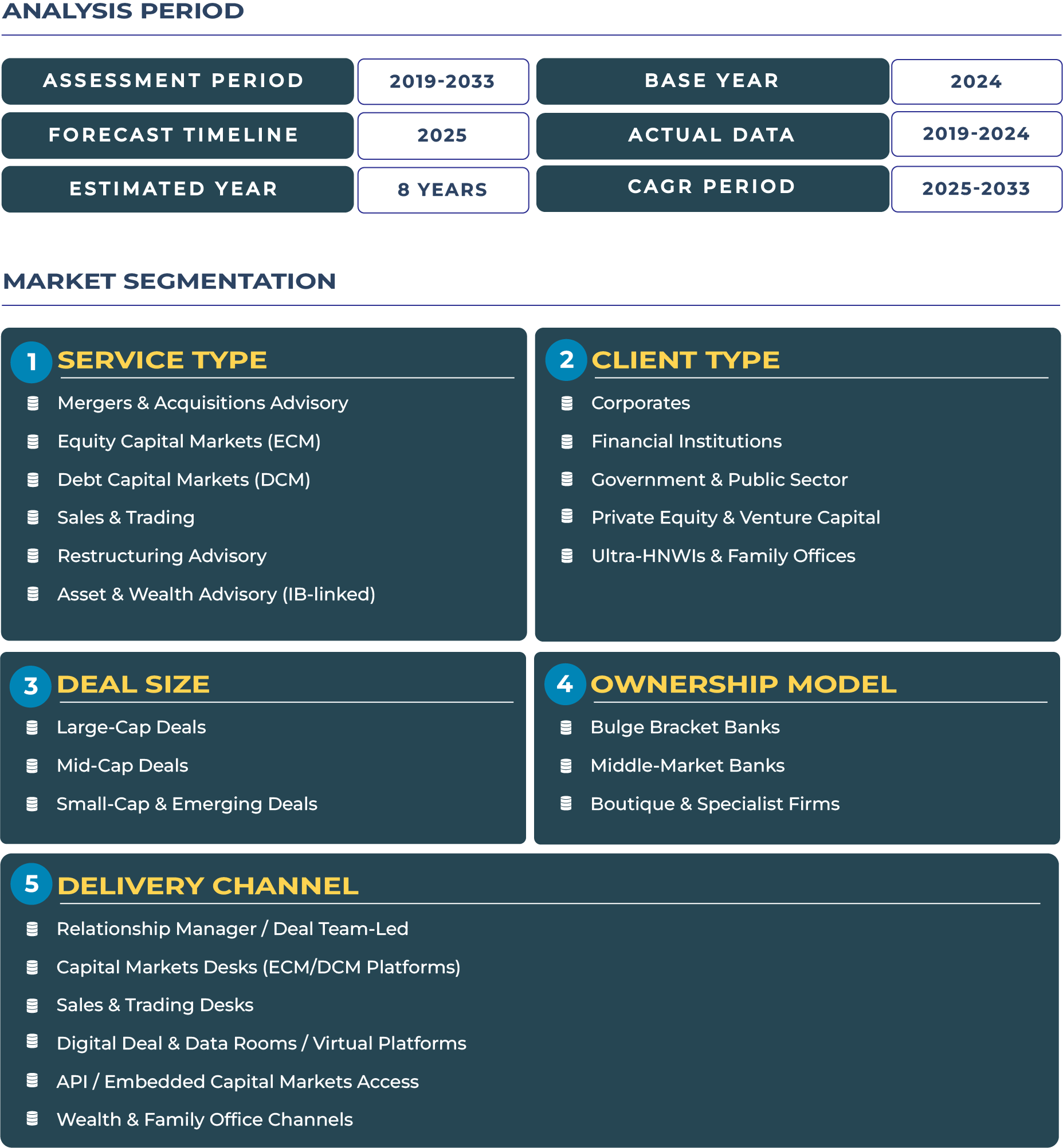Tech-Driven Financial Advisory and Market Expansion Redefining the US Investment Banking Market
The US Investment Banking Market stands at the forefront of global financial innovation, driven by robust capital formation, technology integration, and expanding corporate deal flow. The country’s dominance is built upon its diversified financial infrastructure, advanced digital transformation initiatives, and unparalleled access to liquidity. In 2025, the market is valued at USD 123.2 billion and projected to reach USD 162.9 billion by 2033, reflecting a steady CAGR of 3.6% from 2025 to 2033. The adoption of technologies such as AI-powered analytics, blockchain-based transaction authentication, and cloud-native trading platforms has accelerated advisory efficiency and deal execution. The evolving focus on sector-specific advisory, SPAC transactions, and ESG-linked investments continues to expand the country’s strategic influence across the global investment banking ecosystem.
Note:* The market size refers to the total revenue generated by banks through interest income, non-interest income, and other ancillary sources.
US Investment Banking Market Outlook: Financial Innovation and Strategic Advisory Redefining Capital Markets
The United States remains the global benchmark for investment banking innovation, blending technology-driven efficiencies with regulatory sophistication. The ongoing digital transformation of the financial system has enabled institutions to streamline operations, enhance predictive risk models, and optimize capital allocation. Strategic policy initiatives from the U.S. Department of the Treasury and liquidity measures by the Federal Reserve have strengthened market confidence and investment flows. Additionally, the expansion of ESG-financing frameworks, cross-border advisory services, and private capital access is driving steady growth. The US market’s resilience amid global volatility underscores its maturity, with top-tier banks increasingly offering integrated digital solutions for institutional and retail investors alike.
Drivers & Restraints: Balancing Financial Innovation with Market Volatility
Fintech Evolution and Capital Market Expansion as Core Growth Catalysts
The rapid infusion of financial technology into the US Investment Banking industry is redefining competitive strategy. Institutions are deploying advanced analytics, algorithmic execution systems, and tokenization of assets to increase transparency and reduce execution costs. Corporate financing and merger and acquisition activity remain strong, supported by high liquidity levels and investor appetite for technology and renewable energy deals. The U.S. Securities and Exchange Commission (SEC) reported heightened IPO and SPAC registration activity through 2024, reflecting investor optimism in innovation-led sectors. Fintech-backed advisory platforms are also empowering mid-market clients, opening new revenue channels beyond traditional investment banking structures.
Market Cyclicality and Regulatory Overheads as Key Constraints
Despite structural strengths, the cyclicality of global capital markets continues to challenge revenue predictability in the US Investment Banking sector. Volatility in bond yields, inflationary pressures, and monetary tightening periodically dampen underwriting and trading income. Moreover, compliance with evolving capital adequacy norms under federal regulations has increased operational costs for major banks. Heightened scrutiny under frameworks such as the Dodd-Frank Act and Basel III further constrains leverage flexibility, compelling firms to diversify into asset and wealth management segments to sustain profitability during down cycles.
Trends & Opportunities: From SPAC Renaissance to ESG-Led Financial Solutions
Emerging Trend: Resurgence of SPACs and Direct Listings Fueling Capital Market Dynamism
After a moderate correction in 2023, the SPAC market in the United States has experienced a structured revival. The growing acceptance of direct listings, alternative public offerings, and private-to-public transitions reflects a shift toward more agile financing mechanisms. Investment banks are now integrating digital due diligence and virtual data rooms to accelerate transaction timelines. These innovations have enabled issuers to reach broader investor bases while maintaining valuation transparency. Key financial hubs such as New York, San Francisco, and Chicago are witnessing increased mid-cap deal activity, underscoring regional diversification within the sector.
Opportunity: ESG-Linked Financing as a Cornerstone of Strategic Growth
ESG-linked financing represents one of the most transformative opportunities within the US Investment Banking ecosystem. Sustainable debt instruments, green equity issuances, and climate-focused merger and acquisition advisory are now embedded into major institutions’ strategic portfolios. The U.S. Environmental Protection Agency (EPA) and federal sustainability mandates have catalyzed corporate initiatives aimed at reducing carbon intensity, creating new demand for advisory and structuring expertise. Banks are designing frameworks for sustainability-linked bonds and green IPOs, reflecting the sector’s evolution from profit-centric to purpose-aligned operations. This opportunity not only drives long-term revenue streams but also aligns with investor expectations of ethical capital deployment.
Competitive Landscape: Strategic Realignment Among Market Leaders
The competitive environment in the US Investment Banking market remains highly concentrated, with firms such as JPMorgan Chase, Goldman Sachs, Morgan Stanley, and Citigroup leading in transaction volume and advisory mandates. In early 2025, JPMorgan unveiled a $1.5 trillion strategic investment plan aimed at advancing US infrastructure, semiconductor capacity, and clean energy innovation. Goldman Sachs expanded its technology-driven client coverage model, focusing on artificial intelligence startups and digital transformation sectors. Meanwhile, mid-sized firms are leveraging fintech partnerships to enhance data-driven advisory services and transaction analytics. This strategic diversification reflects a shift toward specialized, technology-integrated advisory ecosystems.







